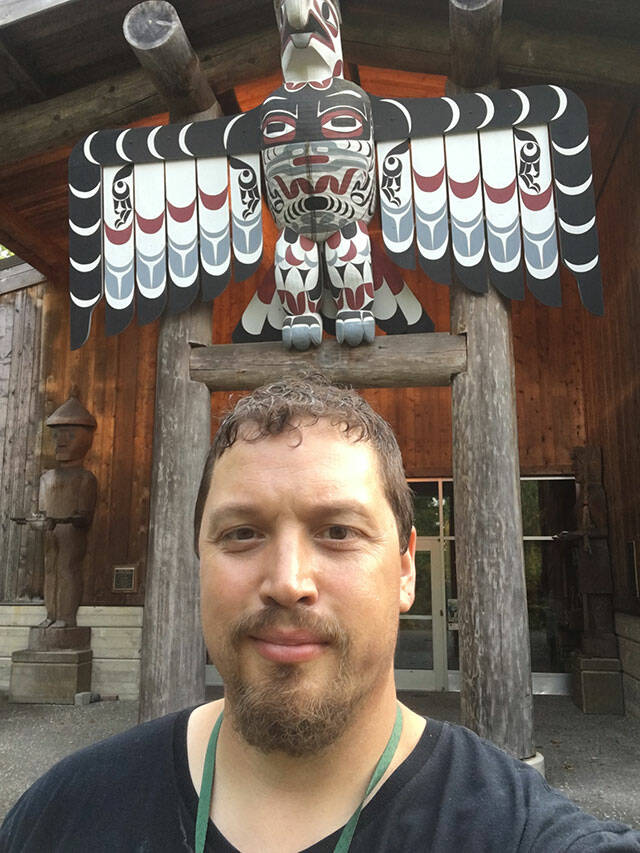Glassblowing allows artist Dan Friday Kwul Kwul Tw to preserve Coast Salish stories for people to learn and enjoy for years to come.
Friday is a member of the Lummi Nation and a lifelong resident of Washington’s Puget Sound region. He owns Friday Glass, an independent glass studio and hot shop in Fremont.
“Glass is so attractive on so many different levels for me,” he said, listing the qualities: it’s hot, dynamic, moving. Then there’s the teamwork side and the industrial feel.
Visitors can hear Friday’s stories about the intersection of his life, artwork and Coast Salish history at the First Friday “Artist Talk with Dan Friday” at 4 p.m. Sunday, Nov. 6 at Vashon Center for the Arts (VCA). This event is only held in person at the theater. Tickets are $20 for general admission; $18 for VCA members; and free for all people under 18 years old.
In collaboration with Seattle’s Stonington Gallery and local native artists, the gallery is presenting a group show art exhibition, “Indigenous Art of the Salish Sea” throughout November. This exhibition displays Native American artists from or working in the Salish sea — including works by Friday — through paintings, prints, and glasswork.
The exhibition runs Nov. 4-27, with a First Friday reception from 5 to 8 p.m. on Friday, Nov. 4. It is free to the public and works are for sale.
As much as glass blowing is a delicate art and creative outlet, glassblowers often have to be a jack-of-all-trades, knowing skills such as electrical work or how to turn a wrench.
“A lot of those things I already had a head start on,” Friday said, referencing his former career as a mechanic and tow truck driver.
It wasn’t pragmatic to find a career as an artist, Friday said. But that changed when he witnessed glassblowing for the first time and saw a path to an apprenticeship at age 20.
He attended The Northwest School in Seattle, then South Seattle Community College and later, Pilchuck Glass School. The “old-world style” of apprenticeship, working for other artists, helped Friday gain a network of connections to other glass-blowing artists, he said.
“I was pretty fortunate,” he said. He worked with artist Paul Marioni and then Washington’s own glass-blowing icon Dale Chihuly. “It definitely influenced my career to see how they approach their processes … You couldn’t pay for an education like that.”
But the passion for creating may have also been inherited. Friday comes from a long lineage of artists; his great-grandfather was a totem pole carver, and his grandmother often worked with her hands to create, he said.
“We come from a largely oral tradition,” he said, noting the importance of stories passed down from generations before.
The last totem pole made by his great-grandfather is standing in front of the Whatcom County Courthouse, a 22-foot structure titled the Centennial Story Totem Pole. This legacy, first crafted in wood, will eventually return to the earth, Friday said.
Glass, on the other hand, allows tales to become tangible by allowing stories to become a permanent record with a future of decomposition unknown.
“Glass, although fragile, is permanent,” he said. “That brings me joy, to tell these stories in a permanent record like glass.”
Friday is often inspired by his family and the stories of the Lummi tribe.
His current enjoyment is working on pieces that reflect stories of current environmental states, whether it be the symbiotic relationships in nature or its inhabitants.
“You can’t choose what inspires you, it’s a thread that you pull on,” he said.
His past works have been displayed worldwide, each encompassing a Coast Salish or Native themes, he said. There’s the bears collection, inspired by his great-great-grandfather and the symbolism of the “Hillare Bear.”
His glass-blown owls are reminiscent of a small woodland fowl who once stayed with him in his cabin for a while.
The glass blown totem poles capture the full-circle reliance of water systems, forests and the animals who both rely on and help sustain those systems.
“A lot of time, people see the physical object, but what brings me great joy is researching the stories,” he said. “That connection, that bridge to the way my ancestors lived.”
Occasionally his art incorporates other elements beyond glass; it could be reef net or anchors, metal work or neon, video or other elements to reject the limits of glass.
His fame in the glass-blowing world also landed him a spot on the third season of the Netflix series, “Blown Away,” during which 10 artists compete in glass-blowing sculpture challenges for the chance to win $60,000.
Overall, Friday said art is subjective and glass is a privilege to work with, but that he hopes meaning is seen, too.
“I don’t think all art needs to be pretty, but I do like to make pleasing-looking things,” he said. “… I have a story I want to tell, but they have an impression to take away.”
To purchase tickets to Friday’s Nov. 6 talk or find out more information, visit vashoncenterforthearts.org/event/a-salish-sea-story-with-artist-dan-friday/.


